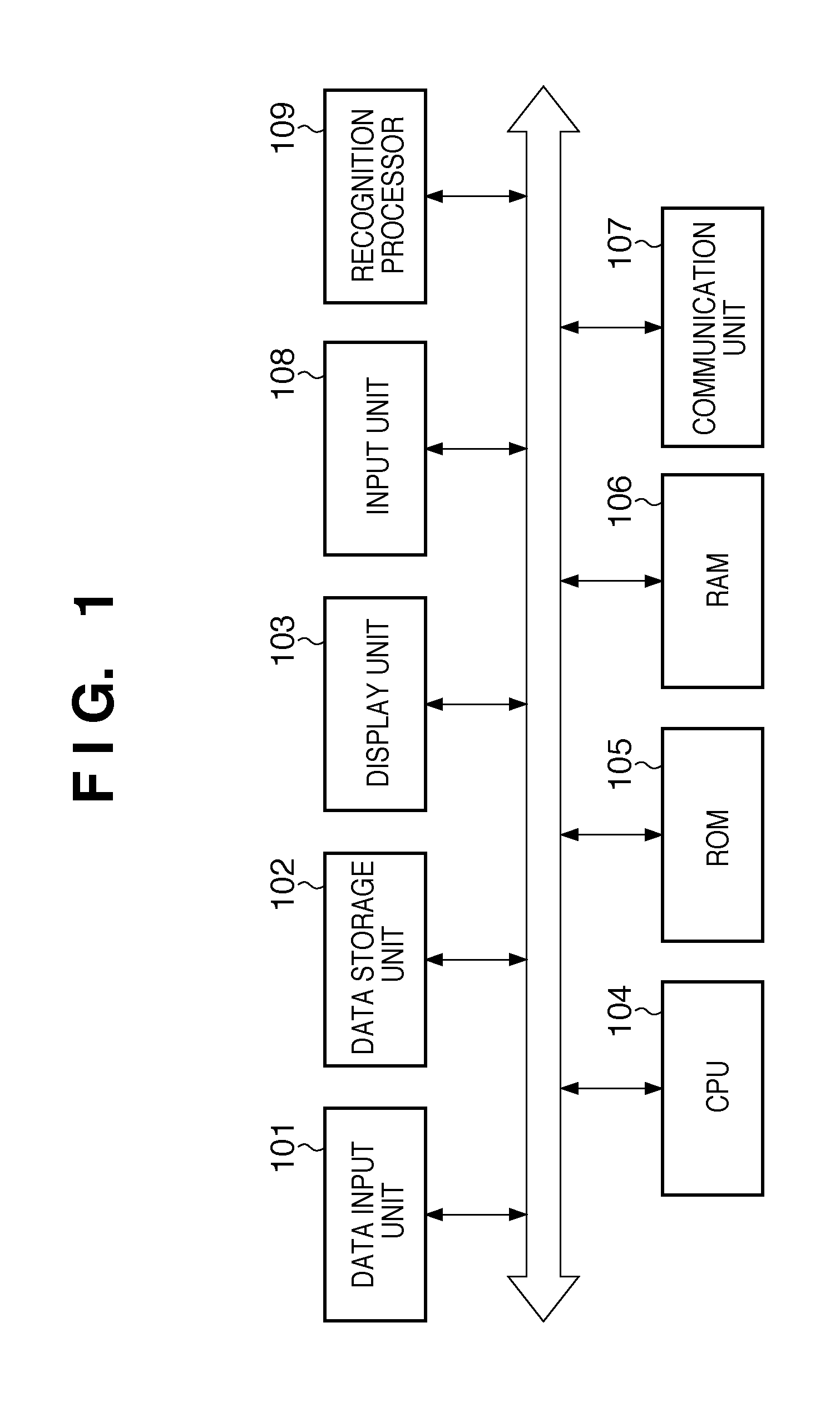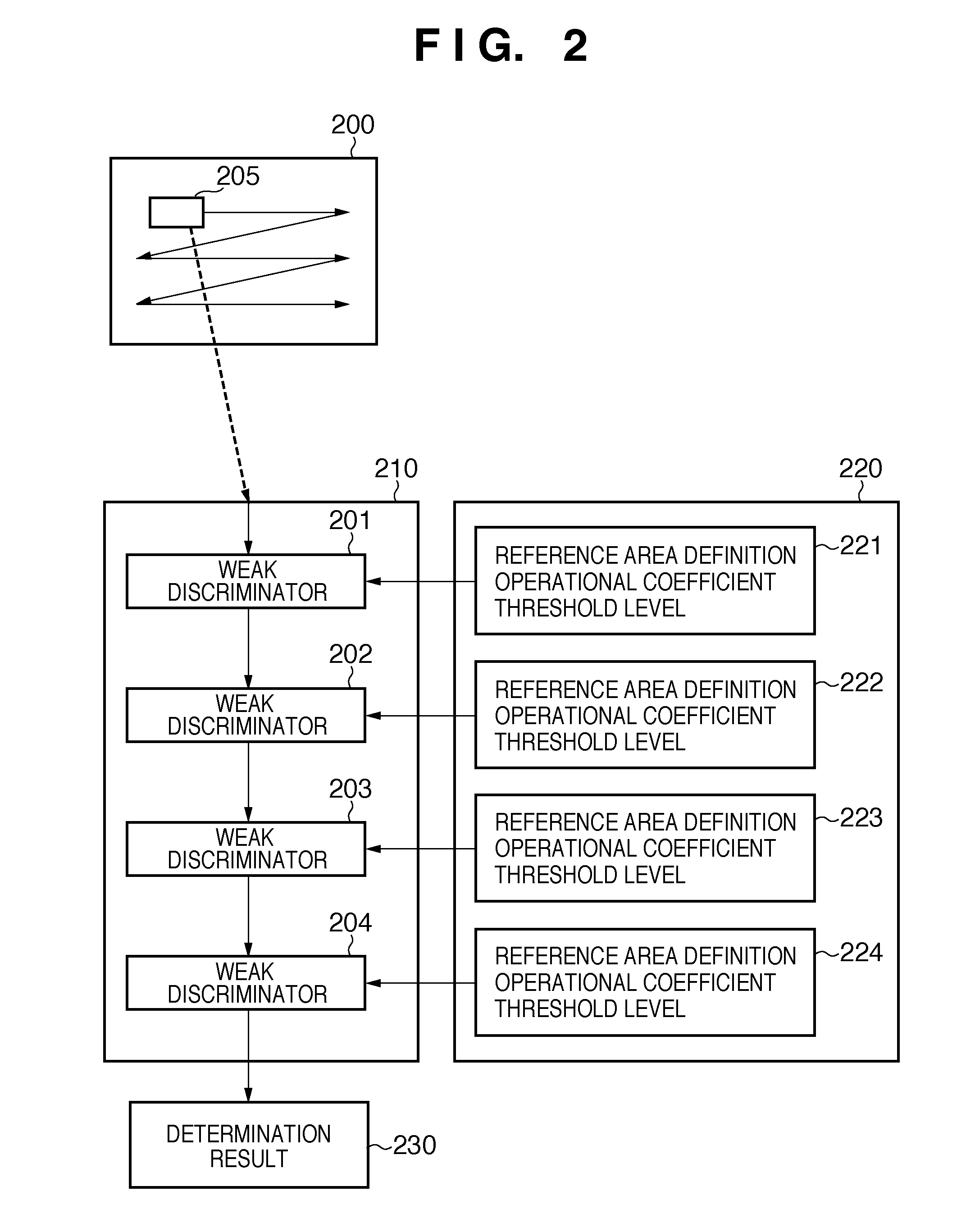Apparatus, system and method for recognizing objects in images using transmitted dictionary data
a dictionary data and object recognition technology, applied in the field of digital data processing schemes, can solve the problems of not integrating face identification results across a plurality of frames together, improving accuracy cannot be expected, and insufficient bibliographic information whether a face is present or not, so as to reduce the data processing load of detecting
- Summary
- Abstract
- Description
- Claims
- Application Information
AI Technical Summary
Benefits of technology
Problems solved by technology
Method used
Image
Examples
first embodiment
[0039]FIG. 1 is a block diagram showing an exemplary configuration of a data processing apparatus that implements an image processing scheme according to a
[0040]A data input unit 101 is a component for inputting image data and includes a known sensor device such as a CCD or CMOS. Data input from the data input unit 101 is stored in a RAM 106 or a data storage unit 102 to be described later.
[0041]The data storage unit 102 is a component for holding image data and consists of a hard disk, floppy (R) disk, CD-ROM, CD-R, DVD, memory card, CF card, smart media, SD card, memory stick, xD picture card, USB memory, or the like. In addition to image data, the data storage unit 102 can store programs and other data. Alternatively, part of the RAM 106 to be described later may be used as the data storage unit 102. A storage device in an apparatus connected by a communication unit 107 to be described later may also be used via the communication unit 107.
[0042]A display unit 103 is a device for ...
second embodiment
[0134]FIG. 10 shows an area 1001 in which an invalidation condition is written. In this configuration, the specified value used in the second embodiment is written in this area, and in step S901 (FIG. 9), the invalidation is determined by referring to the specified value.
[0135]The recognition dictionaries do not need to have a uniform invalidation condition, so that the invalidation condition may vary among the recognition dictionaries. In this case, the data processing apparatus is configured to be capable of addressing any of the several invalidation conditions listed in the second embodiment.
[0136]The area 1001 for writing the invalidation condition may be in any data format. Generally, a known structured data format such as XML is used to write the invalidation condition.
[0137]Thus, according to this embodiment, the data processing apparatus does not need to have a predetermined condition.
[0138]In this case, the present invention can also be applied to a case where all or part o...
fourth embodiment
[0140]In a fourth embodiment, a description will be made of an example in which the data processing apparatus holds recognition dictionaries in advance.
[0141]FIG. 4 is a diagram showing a system that uses the data processing apparatus according to this embodiment. In FIG. 4, the same portions as in FIG. 3 of the first embodiment are given the same numerals as in FIG. 3.
[0142]In FIG. 4, the server 300 holds recognition dictionary designation information 401 in the storage device 301. Similarly, the server 310 holds recognition dictionary designation information 411 in the storage device 311. The server 300 or 310 refers to the recognition dictionary designation information 401 or 411 to generate designation information that designates recognition dictionaries corresponding to the connected communication path (305 or 315).
[0143]The data processing apparatus 320 holds the recognition dictionaries 302 to 304 and 312 to 314 in advance in a storage unit 421 internal to or connected to the...
PUM
 Login to View More
Login to View More Abstract
Description
Claims
Application Information
 Login to View More
Login to View More - R&D
- Intellectual Property
- Life Sciences
- Materials
- Tech Scout
- Unparalleled Data Quality
- Higher Quality Content
- 60% Fewer Hallucinations
Browse by: Latest US Patents, China's latest patents, Technical Efficacy Thesaurus, Application Domain, Technology Topic, Popular Technical Reports.
© 2025 PatSnap. All rights reserved.Legal|Privacy policy|Modern Slavery Act Transparency Statement|Sitemap|About US| Contact US: help@patsnap.com



